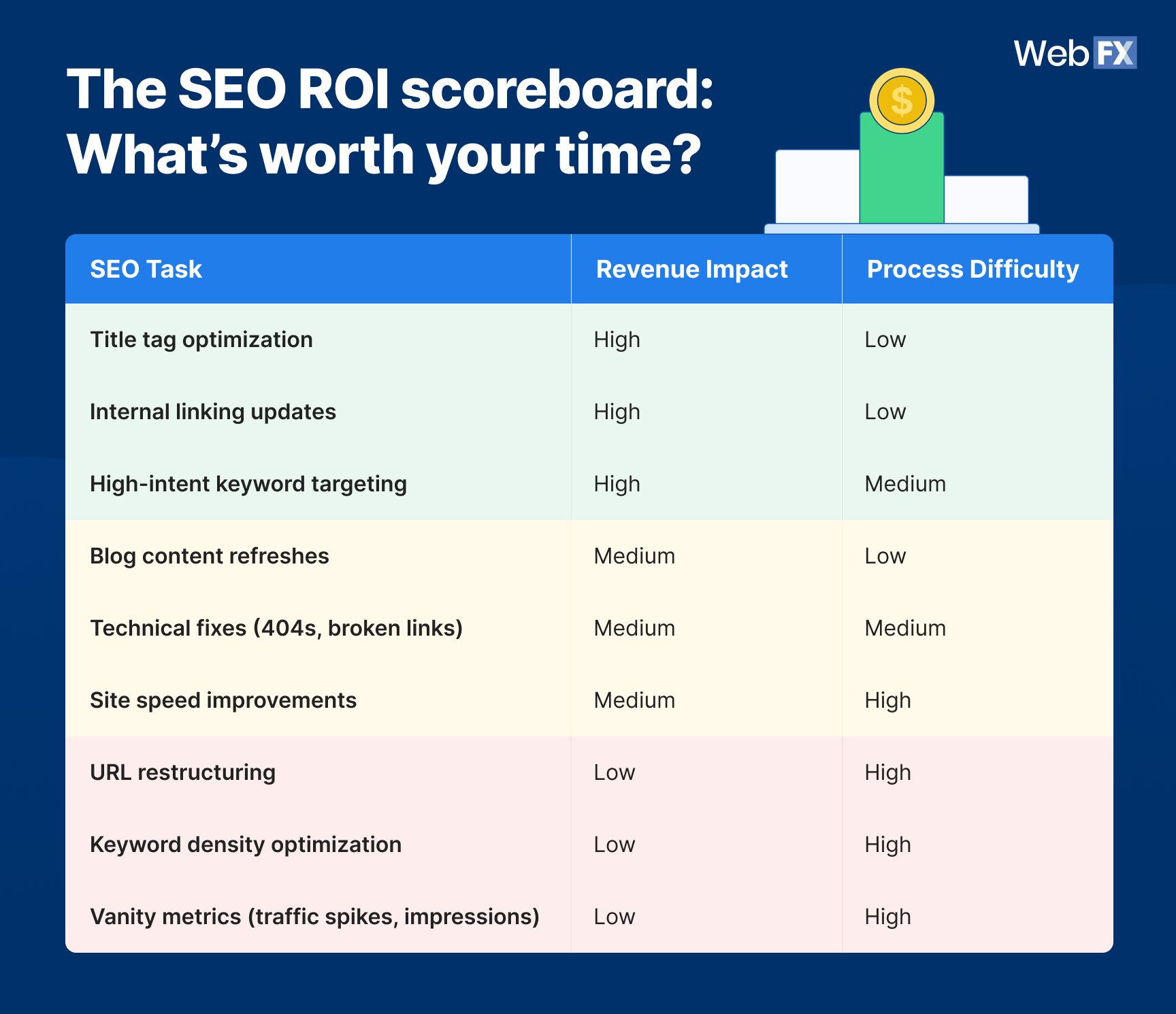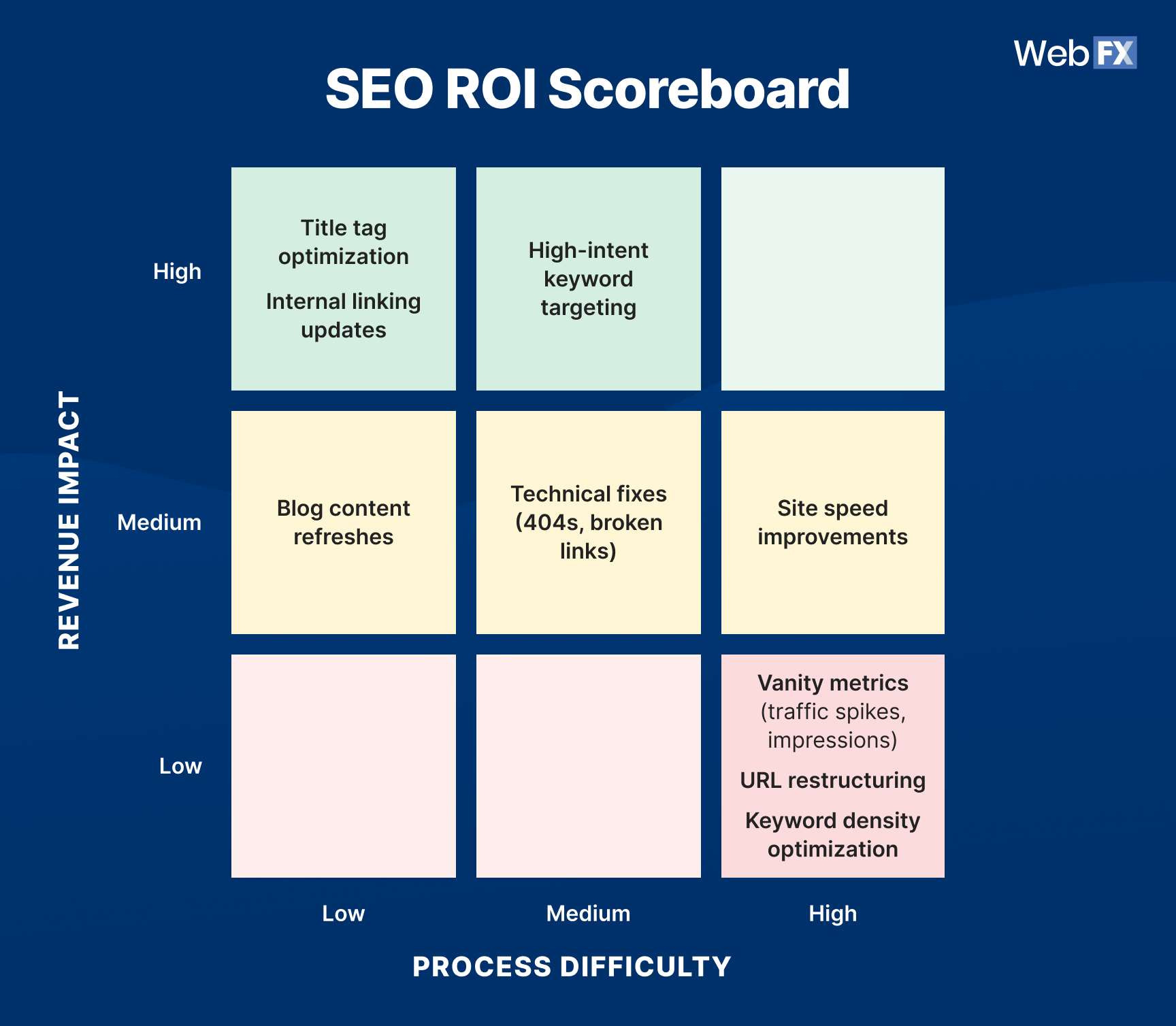Table of Contents
- Why focus matters: Not all SEO tactics are created equal
- The SEO ROI scoreboard: What’s worth your time?
- 1. Optimize title tags for clicks and conversions
- 2. Fix internal links to guide users (and Google)
- 3. Target keywords with high purchase intent
- 4. Refresh old content that’s losing rankings
- 5. Clean up technical errors (but don’t dwell here)
- 6. Improve site speed to reduce bounce (and boost conversions)
- FAQs: Where to focus SEO efforts for max ROI?
- It’s time your SEO pulled its weight
TL;DR: Where to focus SEO efforts for max revenue?
Want the biggest SEO payoff in the shortest time? Prioritize these:
- Title tag optimization – Turn impressions into clicks with headlines that sell.
- Internal linking updates – Guide users (and Google) to your most valuable pages.
- High-intent keyword targeting – Attract buyers, not just browsers.
- Blog content refreshes – Reclaim rankings and leads from outdated posts.
- Technical fixes – Patch the issues silently sabotaging your visibility.
- Site speed improvements – Reduce bounce, improve UX, and win rankings.
If you’re pouring hours into SEO and not seeing returns, you’re not alone. The truth? Most teams waste time on low-impact tasks that feel strategic but barely move the needle.
Meanwhile, competitors quietly fix a few things (like title tags, target keywords, and internal links) and watch their rankings (and revenue) jump.
So, where should you focus your SEO efforts for maximum return on investment (ROI)? Let’s break it down with real-world, revenue-first tactics backed by 25+ years of results at WebFX.
Why focus matters: Not all SEO tactics are created equal
20% of efforts often deliver 80% of the results — meaning the right small set of tasks drives most of your revenue impact.
SEO is powerful, but it’s not magic. Without prioritization, it turns into a black hole of effort with no clear outcome.
The Pareto Principle (80/20 rule) says that 80% of your results come from just 20% of your actions. In SEO, that means a small slice of your initiatives usually drives the biggest revenue gains. Nail those key moves, and you’ll see faster growth with half the grind.
At WebFX, we’ve audited thousands of campaigns and uncovered the same pattern: The SEO tasks that generate the most revenue aren’t always the most complex. Some of the highest-ROI opportunities are hiding in plain sight.
Think of your SEO strategy like renovating a house. Start with the rooms that guests (and Google) actually see — before repainting the attic no one visits.
The SEO ROI scoreboard: What’s worth your time?
We analyzed the impact vs. effort of common SEO tasks, so you don’t have to. Here’s a simple table to help you prioritize what’s worth doing now (and what can wait):

📊 Table Overview
SEO ROI scoreboard
SEO Task
Revenue Impact
Process Difficulty
Title tag optimization
High
Low
Internal linking updates
High
Low
High-intent keyword targeting
High
Medium
Blog content refreshes
Medium
Low
Technical fixes (404s, broken links)
Medium
Medium
Site speed improvements
Medium
High
URL restructuring
Low
High
Keyword density optimization
Low
High
Vanity metrics (traffic spikes, impressions)
Low
High

✅ Start with: High-impact SEO activities that unlock traffic and conversions fast
⚠️ Pause on: Time- and labor-intensive SEO tactics with minimal ROI upside
Want faster returns and fewer SEO regrets? Start with these six proven SEO strategies for revenue growth:
1. Optimize title tags for clicks and conversions
Why it pays off:
Search engine results pages (SERPs) are digital billboards, and your title tags are the headline. An optimized title is the difference between a curious click and a missed sales opportunity. Google uses it to understand page context, and users use it to decide if you’re worth their time.
Well-crafted titles drive more traffic, improve click-through rates (CTR), and give your content a fighting chance against competitors that buy their way to the top.
What to do:
- Include your primary keyword naturally and match the search intent
- Add value-driven language (“Free Guide,” “2025 Tips,” “Fast Results”)
- Keep it under 60 characters for mobile visibility
Real results:
After auditing and optimizing title tags across key landing pages, a metal manufacturer saw a 100% increase in SEO traffic, driving more quote requests for their commercial and residential projects.
2. Fix internal links to guide users (and Google)
Why it pays off:
Internal linking does more than help users click around — it’s one of the most underutilized tools in your SEO arsenal. Strategic internal links are beneficial in:
- Distributing authority across your site
- Helping search engines crawl and index pages faster
- Pushing traffic toward high-converting pages
- Keeping users engaged longer (aka more chances to convert)
When done right, internal links strengthen your site structure and guide both humans and search engines toward your most valuable content.
What to do:
- Add links from traffic-heavy pages to conversion pages
- Use descriptive, keyword-rich anchor text
- Avoid orphaned pages and random link drops
Internal linking is your SEO navigation system — it steers authority, engagement, and discovery straight to the pages that drive performance.
Real results:
By improving keyword targeting and implementing strategic internal links, an industrial manufacturer saw a 43% month-over-month increase in traffic, demonstrating that small structural tweaks can unlock big gains.
3. Target keywords with high purchase intent
Why it pays off:
Some keywords get clicks. Others get customers. Ranking for “how SEO works” might bring in browsers, but ranking for “SEO services near me” brings in buyers. High-intent keywords are the digital equivalent of someone walking into your store and asking, “Can I pay now?”
These keywords often live at the bottom of the funnel, and they’re gold for businesses ready to drive leads and sales, not just traffic.
What to do:
- Research long-tail, bottom-funnel keywords (like “best SEO agency for SaaS”)
- Map them to relevant service or product pages
- Avoid over-optimizing — focus on relevance and intent
Real results:
After optimizing category and subcategory pages for transactional search terms, a used lab equipment supplier saw a 165% increase in organic phone calls, fueling quote requests and sales inquiries.
4. Refresh old content that’s losing rankings
Why it pays off:
Content doesn’t age like wine. Over time, even your best-performing posts can lose traction as competitors publish fresher content, user intent shifts, or search algorithms evolve.
Refreshing outdated content is one of the fastest, lowest-lift ways to reclaim rankings, drive more traffic, and generate new leads — all without creating anything from scratch.
What to do:
- Add new stats, examples, and keywords
- Improve formatting and UX (headers, bullets, CTAs)
- Ensure content relevancy and search intent alignment
- Reindex via Google Search Console
Real results:
Through targeted content pruning and SEO refreshes, Hydroworx achieved a 261% year-over-year increase in SEO leads, proving that old content, when optimized right, can become your biggest lead driver.
5. Clean up technical errors (but don’t dwell here)
Why it pays off:
You can’t build revenue on a broken foundation. Certain issues with technical SEO (like crawl errors, broken links, duplicate content, and redirect chains) silently chip away at your rankings, traffic, and trust. But here’s the catch: Not every technical fix is worth obsessing over.
Focus on mission-critical setbacks that block key pages from ranking or ruin user experience. Clean up the bottlenecks, then move on. It’s all about SEO ROI optimization — fix what impacts returns, skip what doesn’t.
What to do:
- Fix 404 errors, redirect loops, and duplicate pages
- Submit updated sitemaps to Google Search Console
- Defer complex restructuring unless it’s blocking key pages
Real results:
After conducting an internal link audit and tackling technical SEO issues, a water pump manufacturer saw a 49% increase in organic conversion rate month over month, enabling more users to find a distributor and take action.
6. Improve site speed to reduce bounce (and boost conversions)
Why it pays off:
Page speed isn’t just a UX benchmark — it’s a revenue multiplier. Every second your site delays, visitors bounce, leads vanish, and conversions drop. Core Web Vitals are Google’s key performance metrics for speed, responsiveness, and visual stability — and they play a direct role in your search rankings.
Site speed isn’t just nice to have anymore. It’s non-negotiable if you want to compete. You don’t win a race if you’re too slow, and SEO is a zero-sum game.
What to do:
- Compress large images without killing quality
- Use lazy loading for offscreen assets
- Minimize render-blocking scripts and unused code
- Leverage browser caching and a reliable CDN
Real results:
After launching a streamlined website redesign with technical SEO baked in, a packaging supplier saw a 101% increase in organic sessions, validating that speed and structure go hand in hand when it comes to visibility and ROI.
FAQs: Where to focus SEO efforts for max ROI?
1. What are the highest-ROI SEO activities to focus on first?
Start with ROI-focused SEO tasks that offer fast, measurable results:
- Title tag optimization
- Internal linking updates
- High-intent keyword targeting
- Blog content refreshes
- Technical fixes (404s, broken links)
- Site speed improvements
These low-hanging fruits often drive the most SEO ROI without requiring massive overhauls.
2. How do I know if my SEO strategy is actually generating revenue?
You can measure SEO ROI by tracking conversions from organic traffic (such as leads, phone calls, or sales) using tools like Google Analytics and RevenueCloudFX. Tie your strategy back to key business goals: Is it driving qualified traffic, reducing bounce rates, and increasing conversion rates?
3. Should I prioritize content creation or technical SEO for better ROI?
It depends on your current site health. If you’re facing crawl issues, broken pages, or poor load speed, fix technical SEO first. But if your foundation is solid, invest in revenue-driving SEO content, especially updates to existing pages and targeting bottom-funnel keywords.
4. What keywords offer the best return on investment in SEO?
Focus on long-tail keywords with high purchase intent, like “affordable CRM software for startups” or “SEO services for law firms.” These terms may have lower search volume, but they often convert better than broad, top-of-funnel keywords and drive more revenue per visit.
5. How do I prioritize SEO efforts with limited resources?
Use an SEO prioritization matrix based on revenue impact and implementation difficulty. Fix easy, high-return issues first (like title tags, high-intent keywords, or internal links), then scale into more complex SEO strategies. This helps you build momentum, show instant value, and make a stronger case for future investment.
It’s time your SEO pulled its weight
SEO that doesn’t power your pipeline is just…content. And let’s be honest, ranking isn’t the goal — revenue is. Every SEO activity should answer: How will this help someone find us, trust us, and buy from us faster?
So let’s be clear: You don’t need more SEO tasks — you just need the right ones. Start with high-impact SEO tactics that drive revenue and use that momentum to pitch bigger initiatives.
That’s why at WebFX, we align every tactic with your bottom line. No smoke. No mirrors. Just strategy backed by results. With 115+ industry-recognized SEO awards and over $91M in SEO revenue generated, our track record speaks for itself.
Want expert eyes on your strategy? Contact us online or call 888-601-5359 to speak with a strategist today about our heavy-hitting, revenue-focused SEO services. Let’s turn your search presence into an unstoppable money-making machine.
-
 Albert Dandy Velasquez blends SEO strategy with compelling storytelling to help businesses boost their visibility and revenue online. With a B.A. in English and certifications from HubSpot, Semrush, and Google Analytics, he has written and optimized hundreds of articles on organic SEO, content strategy, and user experience. He regularly contributes to the WebFX blog and SEO.com, creating content that helps readers turn marketing goals into measurable results. When he’s off the clock, he’s usually exploring new neighborhoods on two wheels, filming travel content, or chasing golden hour with a coffee in hand.
Albert Dandy Velasquez blends SEO strategy with compelling storytelling to help businesses boost their visibility and revenue online. With a B.A. in English and certifications from HubSpot, Semrush, and Google Analytics, he has written and optimized hundreds of articles on organic SEO, content strategy, and user experience. He regularly contributes to the WebFX blog and SEO.com, creating content that helps readers turn marketing goals into measurable results. When he’s off the clock, he’s usually exploring new neighborhoods on two wheels, filming travel content, or chasing golden hour with a coffee in hand. -

WebFX is a full-service marketing agency with 1,100+ client reviews and a 4.9-star rating on Clutch! Find out how our expert team and revenue-accelerating tech can drive results for you! Learn more
Try our free Marketing Calculator
Craft a tailored online marketing strategy! Utilize our free Internet marketing calculator for a custom plan based on your location, reach, timeframe, and budget.
Plan Your Marketing Budget
Table of Contents
- Why focus matters: Not all SEO tactics are created equal
- The SEO ROI scoreboard: What’s worth your time?
- 1. Optimize title tags for clicks and conversions
- 2. Fix internal links to guide users (and Google)
- 3. Target keywords with high purchase intent
- 4. Refresh old content that’s losing rankings
- 5. Clean up technical errors (but don’t dwell here)
- 6. Improve site speed to reduce bounce (and boost conversions)
- FAQs: Where to focus SEO efforts for max ROI?
- It’s time your SEO pulled its weight

Proven Marketing Strategies

Proven Marketing Strategies
Try our free Marketing Calculator
Craft a tailored online marketing strategy! Utilize our free Internet marketing calculator for a custom plan based on your location, reach, timeframe, and budget.
Plan Your Marketing Budget
 Content Specialist
Content Specialist
What to read next





